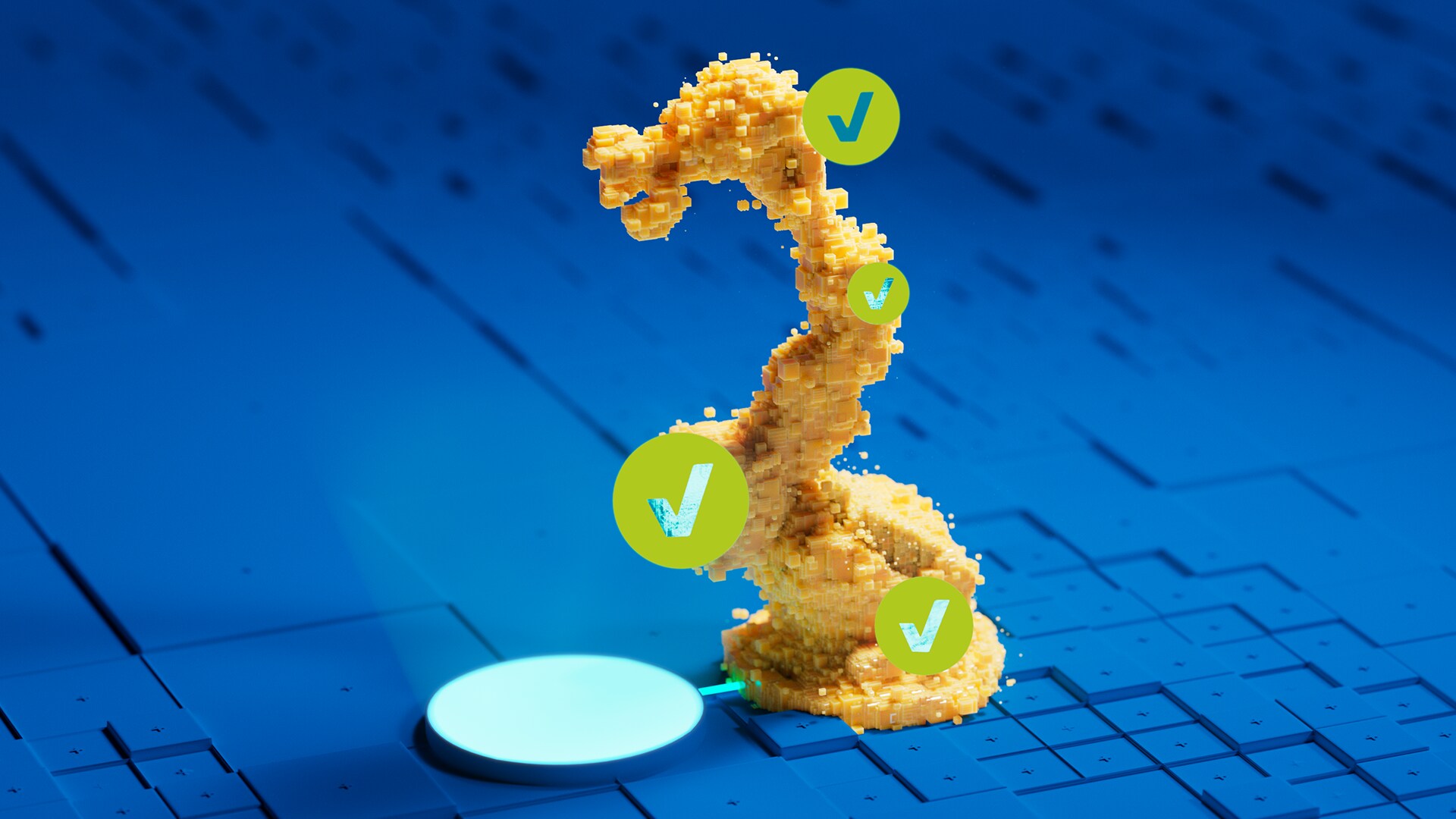Digital twins: virtual simulations of the natural world
A digital twin is a dynamic virtual replica of a real-world physical object, system or process and is designed to optimize, simulate, predict, and analyze its real-life counterpart. It enables users to test a product or process before building it for real and to remotely optimize and maintain real-life applications.
The first digital twin technology was used in 1970 by NASA to run the crucial simulations that brought the Apollo 13 mission safely back to Earth [1]. We’re exploring applications for digital twins across our businesses, e.g. in smart manufacturing and intelligent workplaces.
-
2013
concept of a digital twin was first described [2]
-
25%
potential reduction in number of clinical trials with digital twins [3]
-
2030
the digital twin market is expected to grow to US$ 155.84 billion [4]
What are digital twins?
Digital twins are dynamic, virtual representations of the physical environment, offering real-time insights. They can be created for a wide range of entities, from single products to entire factories and supply chains. Each twin serves a unique purpose but collectively, they enhance understanding and decision-making.
Digital twins have many different use cases today, but each one has three components in common:
- The real-world physical object or process to be modeled, e.g. a bioreactor or a manufacturing process
- A virtual representation of the real-world entity in software form
- A two-way data exchange that links these together.
Enabled by the Internet of Things (IoT) – connected physical objects and processes that continuously send data to and receive them from one another – digital twins are made possible by combining powerful technologies, such as sensors, cloud computing, machine learning, and artificial intelligence (AI).
Unlike conventional computer models, which are sporadically updated with new information, digital twins are dynamic, real-time digital representations that evolve alongside the real-world twin and can interact with it.
This seamless, two-way, real-time interaction makes digital twins a powerful platform for simulating, predicting, optimizing, and controlling physical objects, technologies, products and processes across various industries.
Benefits and advantages of digital twins
“The key idea of using digital twins is to create a detailed digital replica of physical assets, systems, or processes, which enables real-time monitoring, analysis and simulation,” explains Professor Michelangelo Canzoneri, Head of the Global SMARTfacturing program. “The goal is to gain deeper insights into performance, anticipate potential issues before they occur and improve decision-making. By mirroring the real world in a virtual space, digital twins enable optimization of operations, predictive maintenance and innovation in product design and development.
There are different types and maturities of digital twins:
- A product twin digitally mirrors individual products in intricate detail, aiding in identifying and resolving quality issues and enhancing product development.
- An asset twin reflects factory assets in real-time, leveraging data from sensors and IoT devices for predictive maintenance and efficiency optimization.
- The factory twin digitally reconstructs entire production lines, integrating various data sources for flexible production planning and scenario testing.
- An end-to-end twin spans a vast section of the supply chain, facilitating sophisticated planning and logistics strategies.
By simulating and predicting the performance of products in different scenarios – potentially hundreds or thousands of times – flaws or issues can be identified early on, reducing the risk and cost of failure and speeding up the R&D process and scaling it to commercial production.
Once products and manufacturing systems are up and running, digital twins enable process improvements to be made quickly and more efficiently by monitoring and managing objects, processes and systems in real-time. This in turn enables predictive maintenance, i.e. timely repairs to systems before they fail. Using sensors, automation and robotics means maintenance can be carried out remotely to prevent interference with systems while they are running and the introduction errors.
Digital twins can also quickly reconfigure manufacturing processes, providing more resilient and sustainable global supply chains.
“Many manufacturing processes involve supply chains in different sites and countries, each with its own dependencies – from geopolitical issues to the weather and global events such as the Covid-19 pandemic,” says Canzoneri. “Digital twins can help to model planning scenarios, identify quickly the best planning option in a dynamic and complex environment, predict issues or bottlenecks in the overall supply chain and – for example by enabling rapid technology and process transfer – allow alternative suppliers to rapidly get new manufacturing processes up and running to fill the supply chain gap.”

Applications of digital twins
Digital twins are already well established in the construction, automotive, and aerospace industries, where they are used in product design, product life prediction, assembly line logistics, and real-time monitoring of equipment [5].
Digital twins of towns and cities are also used to help urban planners virtually build new developments within towns and cities and explore the impact on traffic, energy consumption, and emissions.
We are exploring the application of digital twins across our business sectors to improve our facilities' performance and sustainability and accelerate product delivery to our customers and patients.
For example, in Life Science, we could build a digital twin of a bioreactor for manufacturing monoclonal antibodies to predict the titer and scalability of any given antibody production method and optimize production for clinical development. This approach could be used for any bioreactor used to make crucial life sciences reagents or therapeutic agents, from bespoke cell lines to rapidly optimized production of new antibiotics.
Digital twins also have potential applications in healthcare. Here, digital twins could be virtual copies of patients, anatomical structures – such as an organ – or digital twins of hospital environments [6]. In the future, personalized digital twins updated at every healthcare touchpoint and continuously collecting data could be used to delay disease onset and personalize treatments for individual patients.
“Patient recruitment is one of the main bottlenecks in clinical trials, and many trials do not include a diverse representation of patients, and more inclusive trial recruitment ensures future treatments are safe and effective for more people,” says Canzoneri. “Creating data models of individual patients, or an entire patient cohort, could address this challenge.”
We hope to build on the digital twin capability we are developing in our Life Science business to realize these benefits for patients in the future.
Our Electronics business also plans to use digital twins to scale up chemical production processes faster and reduce downtime by steering more productive operating windows. Currently we are piloting the use of digital twins to further optimize supply chains, such as the materials and components required for semiconductor manufacturing.
Sharing the potential of digital twins
Digital twin technologies rely on having available the data associated with the real-world object to be able to build a virtual representation. We are leveraging cross-sectoral competencies across our company to develop further and maximize synergies in creating digital twin capabilities within each of our business sectors. But in addition to optimizing efficiency, productivity, and sustainability across our work, we also want to share this unique capability in digital twins with the broader R&D community.
“Adopting and scaling digital twins across our company means we can provide high-quality products to our customers faster, which will help to advance research and development across many different areas worldwide,” says Canzoneri. “We also plan to share our digital twin technology for customers to use in their research setting and endeavors. Through our investment and innovation in digital twins, we aim to expedite the delivery of new technologies, devices, and medicines and accelerate human progress.”
Our contribution
In 2012, the United Nations set out 17 Sustainable Development Goals (SDGs) to address urgent environmental, political, and economic challenges worldwide. Three years later, these goals were adopted by all member states. We are committed to helping achieve these ambitious targets through our work. Our work with digital twins falls under ‘Goal 9 — Industry, innovation, and infrastructure; Target 9.5 — Enhance scientific research and upgrade the technological capabilities of industrial sectors.’ Integrating digital twins across our businesses will make our operations faster and more efficient, thus accelerating human progress. And that's how it will look on the website:
Learn more about SDGsReferences
[1] Barricelli, B.R.; Casiraghi, E.; Fogli, D. A survey on digital twin: Definitions, characteristics, applications, and design implications. IEEE Access 2019, 7, 167653–167671
[2] M. Grieves, “Digital twin: Manufacturing excellence through virtual factory replication,” White paper, 2014. [Online]. Available: http://www.apriso.com/library/Whitepaper_Dr_Grieves_DigitalTwin_ManufacturingExcellence.php
[3] Kesari G. Meet Your Digital Twin: The Coming Revolution In Drug Development. Forbes https://www.forbes.com/sites/ganeskesari/2021/09/29/meet-your-digital-twin-the-coming-revolution-in-drug-development/?sh=626b16bd745f
[4] https://www.grandviewresearch.com/industry-analysis/digital-twin-market
[5] https://digitaldirections.com/4-types-of-digital-twins-basic-overview-with-examples/
[6] Armeni P, Polat I, De Rossi LM, Diaferia L, Meregalli S, Gatti A. Digital Twins in Healthcare: Is It the Beginning of a New Era of Evidence-Based Medicine? A Critical Review. J Pers Med. 2022;12(8):1255. Published 2022 Jul 30. doi:10.3390/jpm12081255
Work with us
Create your digital twins with us!
Do you share our vision of a different world? By joining our team, you could help develop new innovations to accelerate human progress.
View All Jobs Join our Talent Zone

